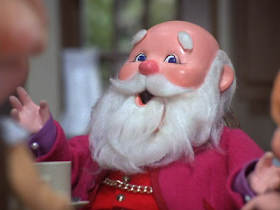The New York Festival of Song presents A Goyishe Christmas To You.
 |
| Lauren Worsham, Stephanie Blythe, Judy Kaye, Joshua Breitzer, John Brancy, Joshua Jeremiah, Alan Kay, Steven Blier. Image © 2011 Kaufman Center. |
Tuesday night's concert by the New York Festival of Song featured the second year of A Goyishe Christmas To You, Steven Blier's program of holiday favorites, written by Jewish composers. This was the program's first appearance at the Merkin Concert Hall, the NYFOS' regular home. The show combines well-known Christmas chestnuts by Jewish composers with 20th century rarities and a new song, submitted in an e-mail from composer Howard Levitsky.
Mr. Levitsky's song, "Candle in the Window (God Bless the Christmas Jews)"opened the program, setting an appropriate, light-hearted tone for the concert. The lyrics examine the disparity of being Jewish and celebrating Christmas anyway, even adding a few extradimensional words from God, admonishing his worshipers not to "think too much." It was engagingly performed by baritone Joshua Jeremiah and soprano Judy Kaye in a breezy, Broadway style.
The program then moved through an astonishing variety of music, from the familiar ("Santa Baby", vamped by nascent diva Lauren Worsham) to obscure nuggets from little-known musicals and old television specials. The best of these: "What Makes Santa Run?" a comic psychoanalysis of St. Nicholas, with Mr. Jeremiah taking the role of Dr. Sigmund Freud.
The biggest name in the little cast of singers was Stephanie Blythe, the potent mezzo-soprano who has become a current fixture at the Met. It was more than thrilling to hear her Wagner-sized voice sing "Let it Snow" and "The Christmas Song," with jazz-inflected piano accompaniment from Mr. Blier. She gave these popular songs full, rich tone and a seductive warmth.
In addition to rarities and favorites, Mr. Blier presented some bold reworkings of familiar songs. "Winter Wonderland" was presented as an ode to gay bliss, with John Brancy and Mr. Jeremiah singing it as a baritonal duet. In a state where gay marriage is at long last legal, the line about Parson Brown and matrimony received hearty approval. "Rudolph the Red-Nosed Reindeer", was reworked in Yiddish. The Johnny Marks classic was sung by tenor Joshua Breitzer in a red yarmulke, accompanied by stepped-up piano and klezmer-style clarinet playing from soloist Alan Kay.
More traditional was "O Holy Night", the soaring carol from French composer Adolphe Adam. (Mr. Blier declared that Mr. Adam was "actually Jewish for one holy night" in his liner notes.) This was sung with emotive power by Mr. Brancy, who clearly relished the chance to open up his instrument and show its full power and range. He sang it a second time in French, using the original words and giving them even more weight.
Following Ms. Kaye's playful rendition of David Friedman's "A Simple Christmas Wish," the concert ended with the whole cast lining up at the piano to share Irving Berlin's immortal "White Christmas." The simple melody was reworked as a triple duet, with pairs of singers splitting up its few short lines. Following this touching performance, the cast cut loose with another Johnny Marks classic: "Rockin' Around the Christmas Tree."

















